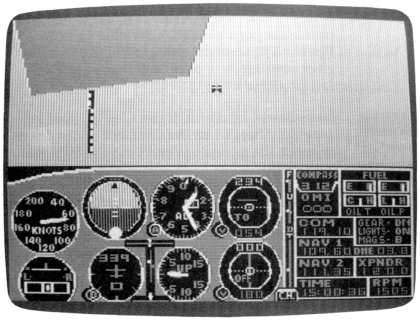40 More Great Flight Simulator Adventures
by Charles Gulick

Finally
Spanaway V
Spanaway V
| North Position: 21211 | Throttle: 8191 (all except IBM) |
| East Position: 6500 | Rudder: 32767 |
| Altitude: 1400 | Ailerons: 32767 |
| Pitch: 359 | Flaps: 0 |
| Bank: 0 | Elevators: 39679 (IBM only) |
| Heading: 340 | Elevators: 40959 (all except IBM) |
| Airspeed: 79 (IBM only) | Time: 15:00 |
| Airspeed: 84 (all except IBM) | Season: 3-Summer |
| Throttle: 12287 (IBM onlv) | Wind: 4 Kts, 160 |
| Note: It's
important to realize that, due to the restrictions of
computer simulation, both the Cessna and Piper will fly absolutely
straight and level, with any given combination of power and trim, at
only one specific altitude. |
||||
  |
Immediately, take a 90-degree
view off your left wing tip. Then, when
the simulator settles down to match the parameters and you're straight
and level, pause. This is the way everything should look when you've entered a pattern and turned downwind perfectly at pattern altitude and pattern airspeed. You're downwind in this case for runway 16 at Spanaway. Because it's a short runway, you can see it all (except the part your wing hides if you're flying the Piper). A longer runway will sometimes require taking 135-degree rear views as well. Note the proximity look, the "fatness," of the runway. Notice, too, its position in relation to your wing. And look at your panel. Your airspeed indicator reads pattern airspeed (75-85 in the Piper, 60-70 in the Cessna). Your VSI tends to average on the center, or zero, position. Your rpm is your standard slow-flight rpm. You achieved straight and level at that power setting by adjusting elevator trim. You're very stable. And you're ready to execute a precision landing. All the ingredients for developing this precision are in this Spanaway adventure-right here. |
|||
 |
|
|||
 |
No two landings are alike. And landing the simulator while flying an airport pattern is about as tough as they get. By comparison, a straight-in approach from way out is child's play. The most important turn is, of course, the turn to final, where you want to roll out precisely lined up. It's by far the most difficult-more difficult than if you're flying a real airplane because you lack an instantaneous panoramic view. In the simulator, it's like landing with only one eye (and that one watery). The preceding guidelines are just that-guidelines. There are instructors who will argue with when and where those guidelines suggest you do what. But the important thing is to be consistent. If you always follow the same procedure, your airwork will steadily improve. Unusual circumstances will dictate departures from procedure. For example, if you have too much altitude downwind, you might want to put on ten degrees of flaps before you turn base, perhaps take off some power, too. Or if you're too low, you can hold off adding carburetor heat until whatever point it suits you, as long as it's before you start your power reductions. You can also make more gradual turns to lose altitude gently. The key thing is to avoid abruptness. Do everything with measured precision, anticipating far enough ahead to make it all smooth. Practice this mode often. Make any adjustments you like to suit your flying style or (good) habits. But once you settle on a procedure that satisfies you, whether it's the one detailed above or your own, follow the procedure all the time. It'll pay off, with the satisfaction that precision brings. The next and final Spanaway adventure will discuss how to fly a pattern from takeoff to touchdown. And (you're used to this now) by the numbers. |
Table of Contents | Previous Section | Next Section
